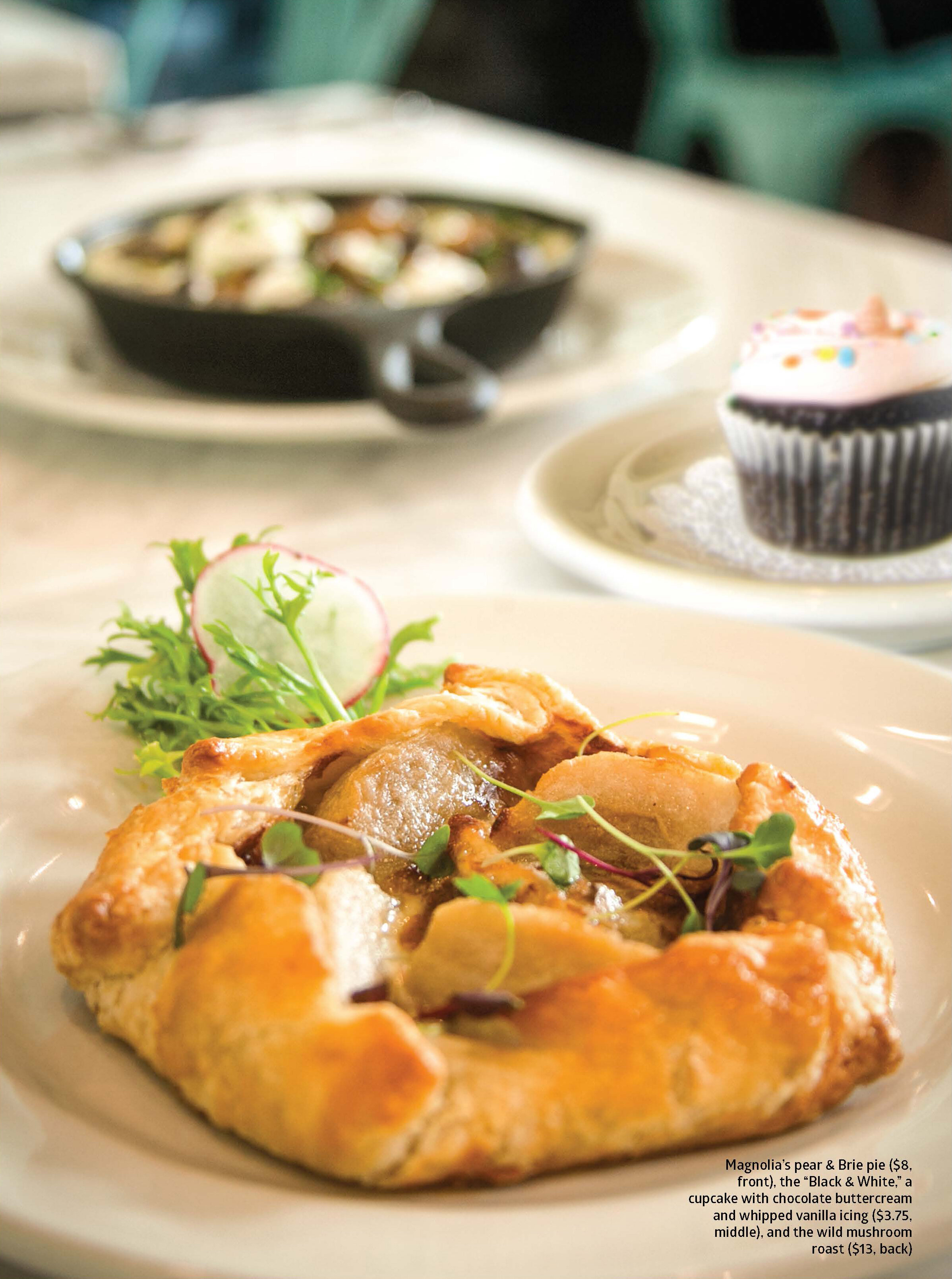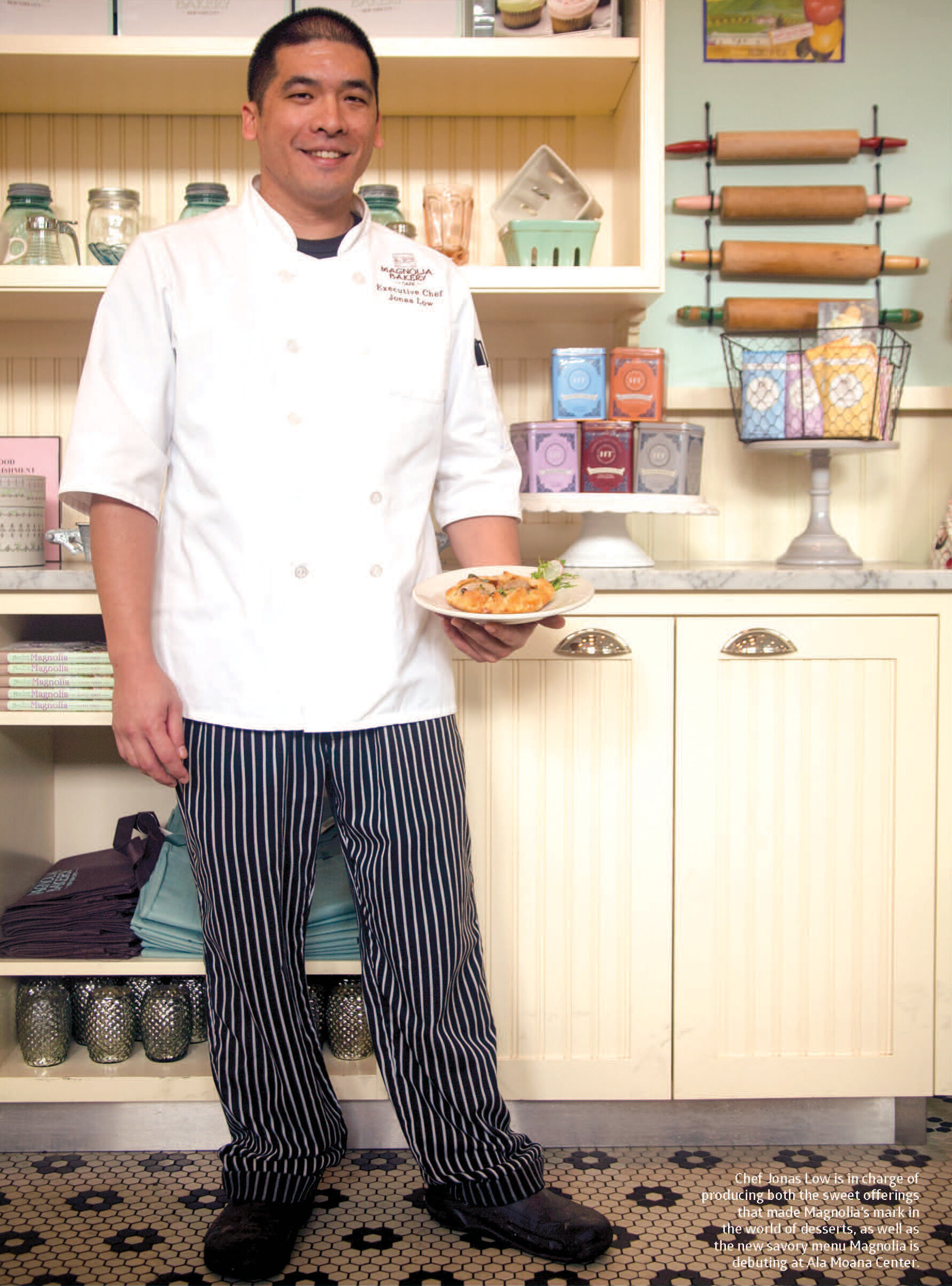SWEET AND FLOUR
A Hawaiʻi-born chef returns home to helm the first ever sweet and savory-serving Magnolia Bakery café.
Summit + Magnolia Bakery // Advertorial
January 2016
FOOD CULTURE, coming out of the late ‘80s and early ‘90s, was all about how “haute” your cuisine could be: tiny portions, brightly arranged on oddly-shaped dishes, a plethora of dipping sauces and (bien sûr) lots and lots of raspberry coulis. It certainly was not concerned with homeyness or nostalgia. But in the summer of ‘96, in the West Village neighborhood of Manhattan, a corner bakery with a different emphasis on culinary delights opened its doors for the very first time.
“All of a sudden, this little tiny bakery opens on a corner, and they’re serving desserts that you had as a child; things that you remember your grandmother making. People hadn’t had these kinds of desserts in a long time,” says Bobbie Lloyd, executive vice president of operations for the now world-famous Magnolia Bakery.
At the time, Magnolia’s flagship cupcakes weren’t even on the menu. But the bakery brand resonated with New Yorkers during a time when supermarkets had all but taken over the role of neighborhood baker.
“During the ‘50s and ‘60s, every neighborhood in each of the boroughs had its bakery that everyone would go to—many of them owned by immigrant families. A lot of second-generation kids in those families grew up to be doctors and lawyers instead of taking over the family business, and those kinds of bakeries began to disappear,” says Lloyd. “New Yorkers do everything on the street, including eating, and Magnolia’s corner location appealed to that street culture, while its products harkened back to a time a lot of New Yorkers had nearly forgotten.”
Twenty years ago, New York City was the frontrunner for creating new food concepts and Magnolia’s approach became the new chic, especially after turn-of-the-millennium HBO sitcom Sex and the City immortalized the brand’s newly-conceptualized, delicate cupcakes. In 2006, the brand changed owners, but both its recipes and its hip aesthetic stayed true.
“When we first bought Magnolia Bakery from the original owner, international expansion really wasn’t even in our minds,” says Lloyd.
But that changed in 2010 with a phone call from a developer in Dubai who was opening the first Bloomingdale’s outside of the United States. To pair with the department store’s fashion brands, the developer wanted quaint and desirable food options, and only Magnolia Bakery’s pastries would do.
“They made it so easy for us that we kind of had to say yes,” Lloyd recalls. “Our thinking was that, if the Dubai location failed, no one would really know. Little did we realize that Dubai is the gateway from Asia to Europe. All of a sudden, we were getting phone calls from all over the world.”
With additional locations in Moscow, Tokyo, Beirut, Seoul, Mexico City and Abu Dhabi, Magnolia is, today, a worldwide brand. The latest addition, an innovative location in Honolulu’s Ala Moana Shopping Center, features the first ever Magnolia café, serving savory menu items alongside the classic desserts that first popularized the West Village bakery.
Trans-Pacific Pastries
“Up until the age of 18, I was a really picky eater. I would pull out the kidney beans from Zippy’s chili and things like that,” laughs Hawaiʻi-born chef Jonas Low, who heads both the Ala Moana location’s bakery and its café. “But after that, I really tried to branch out and try new things. I wanted to be an artist, but it’s hard to make it. I figured everybody’s gotta eat, though, so I decided to channel my artistic energy into food instead.”
Low earned an Associates of Applied Science in Culinary Arts from Leeward Community College and worked at Koʻolau Catering Partners as a pantry and line cook. He soon worked his way up to pastry assistant to the executive pastry chef, Frances Pons. When Pons departed to start his own venture, Low became the head of the pastry department and found his true passion. From there, Low earned a diploma from The Western Culinary Institute in Portland (Le Cordon Bleu Patisseries & Baking) and was quickly hired by Gary Danko, a San Francisco restaurateur whose startups have won multiple awards (Michelin Star, Five Diamond, Relais & Chateau designation).
While working for Danko in San Francisco, Low met his wife, who is from Jordan, and the couple decided to move to the Middle East. This launched a unique opportunity to explore a very different culture and cuisine, challenging Low’s palate with new and exotic flavors.
“I went to stage at an Arabic restaurant and nobody spoke English,” Low recalls. “It was just by eye and by hand-motion that I got to learn: somebody would show me how much salt to put in, just by holding the right amount out in their hand. And I’d have to gauge that and translate it into something that I could understand and remember.”
Low interviewed to become the executive chef at Magnolia’s fledgling Beirut bakery and spent the next two-and-a-half years building up the Lebanon location. But, after the birth of their first child, Low and his wife decided to relocate to Hawaiʻi.
“When Jonas let me know that he was moving back to Hawaiʻi, I knew I had to connect him with the Ala Moana franchisee,” says Lloyd. “I thought it would be really amazing if he could still work with us, but be back home too. It really was meant to be.”
The Ala Moana location is the first to incorporate an official, Magnolia-developed savory menu, which Low is in charge of executing at the same level of excellence as the brand’s pastries.
“I have to split my mind into pastry mode and savory mode,” says Low. “But, as the head of the kitchen, I have to be thinking about both at the same time too. For pastries, you have to follow a formula perfectly. From beginning to end, there are so many things that can go wrong in trying to get the product to come out right.”
Perhaps chief among those considerations is the ingredients themselves, which Lloyd explains can be surprisingly difficult to obtain in foreign countries.
“We have very high standards when it comes to the raw products that we use, and it’s really important to our recipes that our franchisees match their ingredients to our specs,” says Lloyd. “Even in a place like Japan, it took almost two years to get the products either imported or to find a local substitute that matched our specs exactly.”
But that care and attention leads to a consistency in quality that Lloyd says is well worth the hard work.
“Magnolia has a recipe for success,” comments Low. “It’s the brand name, the marketing and, of course, the quality-consistent products that you know you’re going to get coming here.”
But, Lloyd points out that the locations are not carbon copies of one another, and each incorporates aspects of its local culture.
“In Japan, for example, packaging is a really important part of their culture,” she says. “So the experience you have when you’re at the Tokyo location is that they’re going to spend more time at the cash register packaging your items for you. In their culture, they’re willing to wait. In New York City, people don’t have time for that. They want to get in, they want to get out and they want to eat that thing out on the street while they’re walking.”
Each executive chef is hired by the franchisees, and it only makes sense that they would hire from within the local culture. This leads to interesting, locally-inspired, specialty pastries, created by the local chefs and approved by the Magnolia corporate brand.
“In every community that we’re in, we like to give a nod to their culture,” says Lloyd. “In Japan, we do a matcha cupcake, in Mexico we do a tres leches cupcake. We want our locations to develop recipes that they think will work in their local culture.”
Low has some experience creating curated offerings for his local patrons at the Beirut location, and plans on doing the same at the Ala Moana location.
“During the time of Ramadan, a fasting month in Islamic traditions, we would do a date tart because dates are something Muslims can still eat during that month,” says Low. “Dates are very popular as a flavor in Middle Eastern cuisine. But it’s trial and error. We learned that, for example, pistachio is not a popular flavor there at all.
“I’m still in the brainstorming process for developing pastries with a uniquely Hawaiʻi identity. But maybe I’ll take something like the old school ‘Hawaiian Pizza’ from Pizza Hut—that combination of ham and pineapple—I think that might make a really interesting flavor combination for a cupcake,” Low says with a grin.
“I love working with Jonas,” says Lloyd. “He’s a great guy and a very accomplished pastry chef, so we are really looking forward to what he produces at the Hawaiʻi bakery.”
As for Low, he’s happy to be back in Hawaiʻi where he and his wife can “settle in and let the kids grow up a bit” before they decide what the next step is. “From the time I left Hawaiʻi to the time I came back, it’s really been amazing,” he says. “I had no idea how far my journey would take me.”

